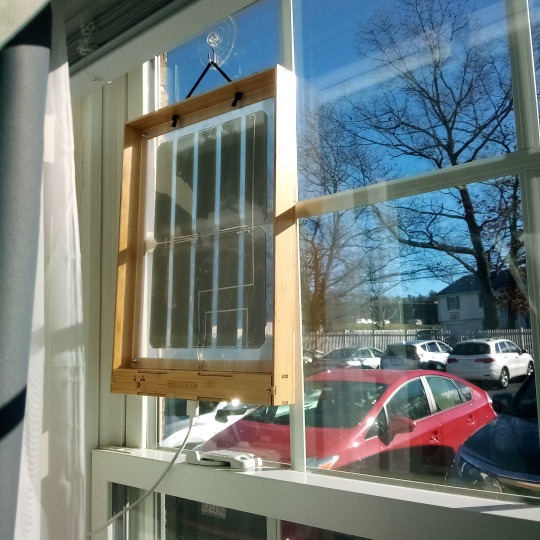Don't wanna be here? Send us removal request.
Photo
ALERT, they are making them again. Pre-orders open, with dual charging ports this time. (I ordered 2)



Product Review: Window Solar Charger
Company/Website: Grouphug Solar
Does it work: Yes. I tested it by using it to charge my cellphone.
Price: $149, I bought mine on sale for $129.
Operation: You’re looking at it. The button turns on yellow, red, or green LED lights that tell you whether the panel is getting enough light to operate, and how charged it’s (included) battery is, but it will charge your devices whether you ever push this button or not.
Assembly/Installation: Comes out of the box fully assembled as shown. Stick the included suction cup to a window and hang it up.
Overall: I like it. You get what you pay for. It does one thing, but it does it well, and I’ve seen desk lamps that were more complicated to use.
I am not affiliated with Grouphug Solar, nor am I making any money off this.
118 notes
·
View notes
Text

Just in case you think Solarpunk is a modern concept, observe the public-street-facing grapevine shade/food production trellis in the background of this pic from Ghent, Belgium, ca. 1515. (Book of Hours page posted by: lazyreenactorgirl)
1 note
·
View note
Text

In Idaho, beavers can be something of nuisance, chewing down trees and building dams that flood yards and fields. In the 1930s, officials began trapping beavers near cities and towns and dropping them — sometimes by parachute — into remote areas.

In one such area, Baugh Creek, beavers have visibly altered the landscape, as shown in newly released satellite imagery from NASA. Beavers erected dams that formed ponds and flooded meadows, supporting the growth of grasses and shrubs.
Flooded stretches along Baugh Creek are well guarded against drought and fire. When the Sharps Fire burned through the area in 2018, it left unsinged those parts where beavers had settled. (picture above)
246 notes
·
View notes
Text
Why waste the rain?
I'm obsessed with gardening systems that utilize rainwater without the use of barrels or cisterns. My ultimate fav is using bioswales to catch and filter stormwater on the street.





Fun addition: Dams that utilize trees to catch dirt/ stop erosion, and prevent disaster that can come from broken dams.

8K notes
·
View notes
Text
"NJR Clean Energy Ventures owns and operates the floating solar farm, which covers 17 acres of the Canoe Brook reservoir in Short Hills, New Jersey. NJR CEV and New Jersey American Water held a ribbon-cutting ceremony for the project yesterday.
The floating solar farm consists of 16,510 solar panels, and the clean power they generate is enough to power 1,400 homes annually. It will provide around 95% of the power needs for New Jersey American Water’s Canoe Brook Water Treatment Plant.
Floating solar consists of PV panels attached to rafts. The water keeps the solar panels cool, thus increasing efficiency, and the panels also reduce evaporation to nearly zero."
81 notes
·
View notes
Photo
Still have it, still works the same.



Product Review: Window Solar Charger
Company/Website: Grouphug Solar
Does it work: Yes. I tested it by using it to charge my cellphone.
Price: $149, I bought mine on sale for $129.
Operation: You’re looking at it. The button turns on yellow, red, or green LED lights that tell you whether the panel is getting enough light to operate, and how charged it’s (included) battery is, but it will charge your devices whether you ever push this button or not.
Assembly/Installation: Comes out of the box fully assembled as shown. Stick the included suction cup to a window and hang it up.
Overall: I like it. You get what you pay for. It does one thing, but it does it well, and I’ve seen desk lamps that were more complicated to use.
I am not affiliated with Grouphug Solar, nor am I making any money off this.
118 notes
·
View notes
Link

5 notes
·
View notes
Link
1 note
·
View note
Photo



Product Review: Window Solar Charger
Company/Website: Grouphug Solar
Does it work: Yes. I tested it by using it to charge my cellphone.
Price: $149, I bought mine on sale for $129.
Operation: You’re looking at it. The button turns on yellow, red, or green LED lights that tell you whether the panel is getting enough light to operate, and how charged it’s (included) battery is, but it will charge your devices whether you ever push this button or not.
Assembly/Installation: Comes out of the box fully assembled as shown. Stick the included suction cup to a window and hang it up.
Overall: I like it. You get what you pay for. It does one thing, but it does it well, and I’ve seen desk lamps that were more complicated to use.
I am not affiliated with Grouphug Solar, nor am I making any money off this.
#solar#apartment living#solar panel#Grouphug Solar#window solar#product review#solarpunk#literally a wire window ornament
118 notes
·
View notes
Link
“-Key to the thermal performance of the terrace house, especially during the warmer months, was the sash window, an impressive machine. When functioning properly, counterweights balance the weight of the glass and wood frames, and it can be opened from both the top, the bottom, or both. When both the top and bottom are opened, a natural flow of hot air out and cooler air in develops, which also helps clear a room of stale smells and smoke. The carefully weighted mechanism allowed subtle regulation of the aperture, and unlike casement windows, they weren’t susceptible to sudden blasts of wind shearing them from their frames.-”
-And damn the counterweights, this ‘open both the top and the bottom a bit’ heat convection trick works fine with modern sash windows too.
1 note
·
View note
Link
FTA: “Enzymes that rapidly break down plastic bags have been discovered in the saliva of wax worms, which are moth larvae that infest beehives.
The enzymes are the first reported to break down polyethylene within hours at room temperature and could lead to cost-effective ways of recycling the plastic.
The discovery came after one scientist, an amateur beekeeper, cleaned out an infested hive and found the larvae started eating holes in a plastic refuse bag. The researchers said the study showed insect saliva may be “a depository of degrading enzymes which could revolutionise [the cleanup of polluting waste]”.
Polyethylene makes up 30% of all plastic production and is used in bags and other packaging that make up a significant part of worldwide plastic pollution. The only recycling at scale today uses mechanical processes and creates lower-value products.”
…
“Wax worm larvae live and grow in the honeycombs of beehives and feed on beeswax, which may be why they have evolved the enzymes. Another possibility is the enzymes break down the toxic chemicals produced by plants as a defence and which are similar to some additives in plastics.
Prof Andy Pickford, the director of the Centre for Enzyme Innovation at the UK’s University of Portsmouth, said the discovery of the enzymes in wax worm saliva was exciting. “The reaction happens within a few hours at room temperature suggesting that enzymatic breakdown may be a route to making use of polyethylene waste.”“
186 notes
·
View notes
Link
FTA: “Founded more than 2,000 years ago, this settlement in the Rhine River valley is one of the oldest towns in Germany. Its city walls have survived, along with the ruins of a moated castle dating back to the 12th century. It’s also home to the highest cold-water geyser in the world, a big tourist draw. But today, visitors have another reason to come to Andernach — its city gardens.
“If you feel like picking something for dinner, feel free,” said Anneli Karlsson, the project coordinator of the Edible Cities Network in Andernach. “That’s our motto: Feel free to pick.”
Andernach, with a population of around 30,000 people, is known as an “edible city.” That means many of its public green spaces are used to grow food that anyone can harvest free of charge.
The city’s administration launched the project in 2010. The idea was to get locals more engaged in their community and raise awareness about how food is grown.
“You don’t feel such a relationship to a tulip or a rose, as you do to maybe a salad that you’re going to pick tomorrow for your own dinner,” said Karlsson.
…
“But Andernach’s gardens aren’t just about food. Karlsson said the project is unique because it hires unemployed people to maintain the plant beds, alongside a team of gardeners.
“It has changed my life,” said Jörn Schamari, a former truck driver. He suffered burnout and was out of work when he came across the edible city initiative several years ago.
“This project helped me bounce back. And from next year, I’ve been promised a permanent position as a gardener here. The project has also changed my relationship to plants. Before, I had absolutely no interest in them, but now I even plant fruits and vegetables at home." “
…

“Urban populations are expected to grow rapidly in the coming decades, only adding to food supply challenges. By 2050, nearly seven out of 10 people will live in cities, according to the World Bank. Artmann said there needs to be more awareness about just how dependent cities are on rural areas for their food.
"So there’s really a need to put food self-sufficiency — and also how and where food is produced and comes into the city — onto the political agenda. And this is still lacking,” she said. While the focus of Andernach’s edible city project is not food security, Karlsson hopes it will “open people’s eyes to how you can use one square meter of land and harvest enough for at least a couple of meals.”
Inner-city gardens can also help mitigate the effects of climate change, for example by providing cool shady areas in summer or absorbing runoff from heavy rainfall. “
80 notes
·
View notes
Photo
Hot take: set the experiment up, let the slime mold make it’s map, then remove the food flakes from a handful of cities that have had repeated catastrophic hurricanes, wildfires, etc., and let the map redraw itself.
There. Now you know how America might look after the first major wave of climate refugees pick up and move.

Slime mold was grown on an agar gel plate shaped like America and food sources were placed where America’s large cities are.
The result? A possible look at how to best build public transportation.
I just really like the idea of slime mold on a map of the US. It’s beautiful.
#solarpunk#urban planning#highway planning#organic computer#slime mold#it works for oatmeal bits#this is brilliant
234K notes
·
View notes
Text
In France, all large parking lots now have to be covered by solar panels

In France, solar just got a huge boost from new legislation approved through the Senate this week that requires all parking lots with spaces for at least 80 vehicles – both existing and new – be covered by solar panels. Starting July 1, 2023, smaller carparks that have between 80 and 400 spaces will have five years to be in compliance with the new measures. Carparks with more than 400 spaces have a shorter timeline: They will need to comply with the new measures within three years of this date, and at least half of the surface area of the parking lot will need to be covered in solar panels. According to the government, this plan, which particularly targets large parking areas around commercial centers and train stations, could generate up to 11 gigawatts, which is the equivalent of 10 nuclear reactors
This is the way! No brainer.
France’s national rail service SNCF also plans to install some 190,000 square meters of solar panels in 156 stations throughout the country by 2025 and 1.1 million square meters by 2030, all with the aim to reduce energy consumption by 25%.
2K notes
·
View notes
